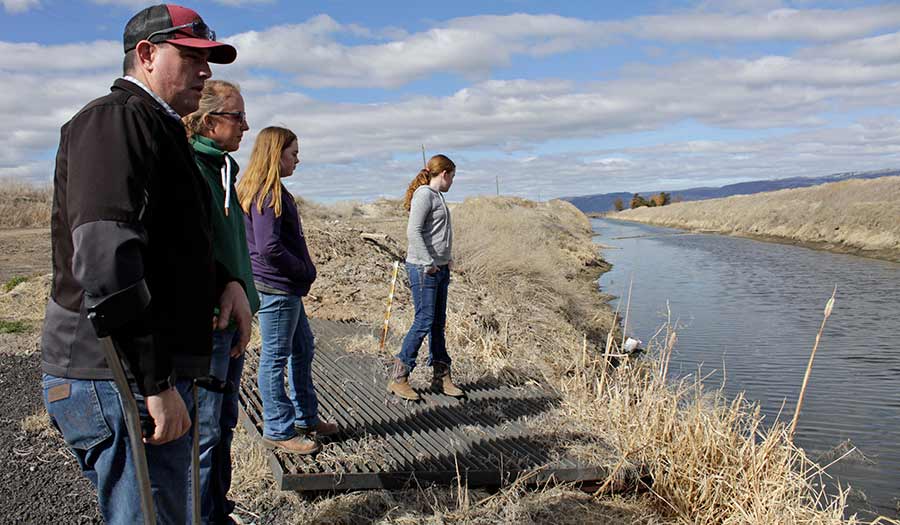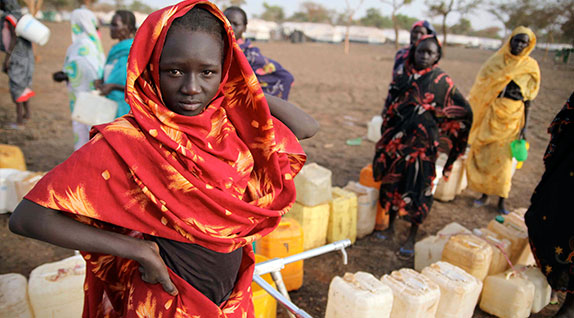 AP/Gillian Flaccus
AP/Gillian Flaccus
World News Desk
Learn the why behind the headlines.
Subscribe to the Real Truth for FREE news and analysis.
Subscribe NowPORTLAND, Oregon (AP) – One of the worst droughts in memory
in a massive agricultural region straddling the California-Oregon border could
mean steep cuts to irrigation water for hundreds of farmers this summer in
order to sustain endangered fish for local tribes.
The U.S. Bureau of Reclamation, which oversees water
allocations in the federally owned Klamath Project, is expected to announce
this week how the season’s water will be divvied up after delaying the decision
a month.
For the first time in 20 years, it is possible that the
1,400 irrigators who have farmed for generations on 225,000 acres of reclaimed
farmland will get no water at all—or so little that farming would not be worth
it. Several tribes in Oregon and California are equally desperate for water to
sustain threatened and endangered species of fish central to their heritage.
A network of six wildlife refuges that make up the largest
wetland complex west of the Mississippi River also depend on the project’s
water, but will likely go dry this year.
The competing demands over a vanishing natural resource
foreshadow a difficult and tense summer in a region where farmers,
conservationists and tribes have engaged in years of legal battles over who has
greater rights to an ever-dwindling water supply. Two of the tribes, the
Klamath and Yurok, hold treaties guaranteeing the protection of their
fisheries.
The last—and only—time that water was cut off for
irrigators, in 2001, some family farms went out of business and a “bucket
brigade” protest attracted 15,000 people who scooped water from the Klamath
River and passed it, hand over hand, to a parched irrigation canal.
Tribes, for their part, say the fish are intertwined with
their existence going back millennia. The Klamath believe the sucker fish—the
first fish to return to the river after the winter—were created to provide for
and sustain their people. Further downstream, the Yurok define the seasons by
the fish runs.
“Some people say that because of those fish, our people are
still here,” Don Gentry, chairman of the Klamath Tribes, said of the sucker
fish. “They’re the canary in the coal mine. If they die out, it shows you that
something is going very wrong here in the Basin.”
This season, amid a pandemic and an ever-deeper partisan
divide, some in the region fear what is to come.
“I think that the majority of people understand that acts of
violence and protest isn’t going to be productive, but at the same time people
down here are being backed into a corner,” said Ben DuVal, a farmer and
president of the Klamath Water Users Association. “There’s a lot of farms that
need a good stable year this year—myself included—and we’re not going to get
that this year. I’m questioning the future.”
The situation in the Klamath Basin was set in motion more
than a century ago, when the U.S. government began drawing water from a network
of shallow lakes and marshlands and funneling it into the dry desert uplands.
Homesteads were offered by lottery to World War II veterans who grew hay, grain
and potatoes and pastured cattle.
The project turned the region into an agricultural
powerhouse but permanently altered an intricate water system that spans
hundreds of miles from southern Oregon to Northern California.
In 1988, two species of sucker fish were listed as
endangered under federal law, and less than a decade later, coho salmon that
spawn downstream from the reclamation project, in the lower Klamath River, were
listed as threatened.
The water necessary to sustain the coho salmon downstream
comes from Upper Klamath Lake—the main holding tank for the farmers’ irrigation
system. At the same time, the sucker fish in the same lake need at least 1 to 2
feet of water covering the gravel beds that they use as spawning grounds.
In a year of extreme drought, there is not enough water to
go around. Already this spring, the gravel beds that the sucker fish spawn in
are dry and water gauges on Klamath River tributaries show the flow is the
lowest in nearly a century. A decision late last summer to release water for
irrigators, plus a hot, dry fall with almost no rain has compounded an already
terrible situation.
“Given what I know about the hydrology, it’s just impossible
for them to make everyone happy,” said Mike Belchik, a senior water policy
analyst for the Yurok Tribe in Northern California. “There’s just not enough
water.”
The Klamath Water Users Association sent a warning to its
membership last week saying there would be “little to no water for irrigation
from Upper Klamath Lake this year.” It is holding a public meeting Wednesday to
provide more information.
Meanwhile, sucker fish in the Upper Klamath Lake are
hovering near dried-up gravel beds, fruitlessly waiting for water levels to
rise so they can lay eggs, said Alex Gonyaw, a senior fisheries biologist for
the Klamath Tribes.
“You can see them sort of milling around out in the lake
water. They’re desperately trying to get to this clean, constant lake water
that they need,” he said. “It’s going to be like 2001. It’s going to be,
hopefully not catastrophic but very, very stressful for people and fish.”
In 2001, the Bureau of Reclamation cut off water for 90
percent of the farms served by the Klamath Project when a drought cut water
supply by two-thirds. The decision to do so went all the way to then-Vice
President Dick Cheney and marked the first time farmers lost out to tribes and
fish.
The water was held in Upper Klamath Lake for endangered
sucker fish and allowed to run down the Klamath River for threatened coho
salmon, rather than moving through the intricate series of canals to farms
before dumping into wildlife refuges.
In previous severe droughts, including in the early 1990s,
the federal government allowed more water to flow to farmers—a policy that
contributed to the current crisis, said Jim McCarthy, of WaterWatch of Oregon.
Some are hoping this year’s crisis will help all the
interested parties hash out a water-sharing compromise that could save both the
ecology and economy of the Klamath River Basin before it collapses entirely.
“We can’t rely on historical water supplies anymore. We just
can’t,” said Amy Cordalis, counsel for the Yurok Tribe and also a tribal
member. “It’s no one’s fault. There’s no bad guy here—but I think we’d all do
well to pray for rain.”
- Real Truth Magazine Articles
- WEATHER & ENVIRONMENT
 Our Water Crisis – Reversing the Irreversible
Our Water Crisis – Reversing the Irreversible
Other Related Items:
More on Related Topics:
- With Sewage Gushing into Sea, U.S. and Mexican Border Towns Plead for Help
- Mass Fish Death in Mexico’s Chihuahua State Blamed on Severe Drought
- It Is So Hot in Mexico, Howler Monkeys Are Falling Dead from the Trees
- Too Much Water, and Not Enough: Brazil’s Flooded South Struggles to Access Basic Goods


